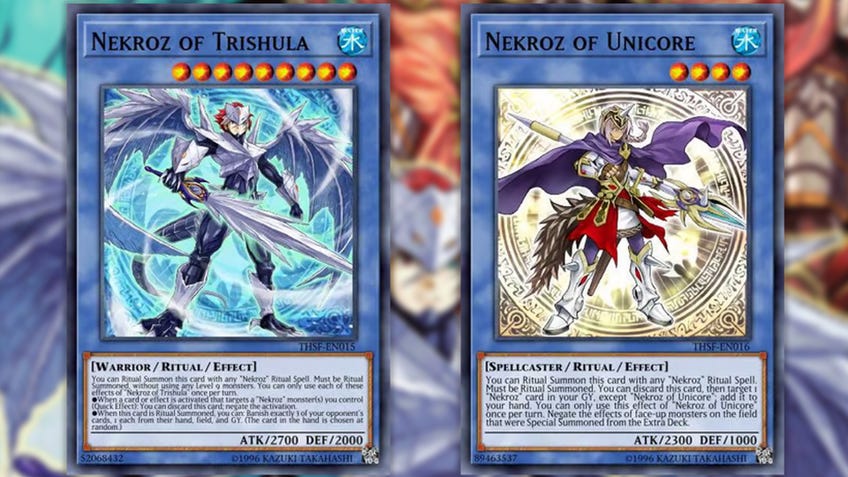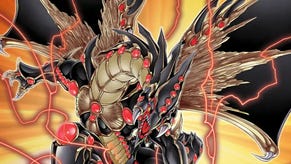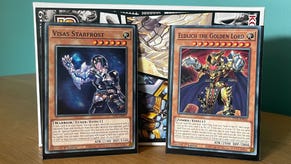Yu-Gi-Oh!’s strangest monsters are back, and they could shake-up the TCG’s competitive scene
Looking back on the long and bumpy history of ritual monsters.
In the 2002 booster pack Spell Ruler, the first-ever ritual monsters in the history of Yu-Gi-Oh! were introduced. The poster child of this new type of monster was Maximillion Pegasus’ Relinquished - and doesn’t that make sense? A monster as creepy and unnerving as a single-eyed idol who sucks up its enemies to give itself power feels like it could only be brought into existence through some form of ritual sacrifice, a primordial being with otherworldly abilities. And in the early days of Yu-Gi-Oh!, a Level 1 ritual monster that could steal any monster your opponent controlled was powerful, imprinting on the TCG’s competitive meta with intent. No wonder it was the cover monster for the set.
Ritual monsters were something new to the game at that point: a creature that could only be summoned through the use of a Ritual spell card and a tribute equivalent to or higher than the level of that monster. (For example, Relinquished was level 1, meaning any monster could be used as tribute.) It was certainly extra steps and more conditional than the standard tribute summon, but the payoff was a more powerful creature who could turn the tide of battle.
Most of the time, anyway. Hungry Burger may be an iconic card with a beloved design today, but it was not worthy of the steps necessary to summon it as a ritual monster.
Still, it felt like ritual monsters had a bright future. If a Ritual could bring monsters like Relinquished into the game, what else could it offer? Support for the monster type has fallen in recent years, and power creep means even powerful examples like the aforementioned titan of the early years of Yu-Gi-Oh! were soon left by the wayside. This doesn’t mean Konami hasn’t kept trying, with this year’s Wild Survivors set including an all-new ritual monster archetype, an unusual sight for sure. So what changed, and what could the future be for this unique style of monster?
During the early days of Yu-Gi-Oh!, ritual monsters benefited from the general slowness of the card game. The fact that players generally needed to summon a monster then tribute it to get their most powerful creatures onto the field actually made ritual monsters theoretically the fastest way to summon high-power monsters onto the field, provided you had the necessary materials. Looking at Relinquished, you could summon the necessary tribute in the same turn as activating Black Illusion Ritual to get the fearsome creature onto the field in the very same turn. Without something like Ultimate Offering, that could help a player perform multiple normal summons in the same turn, getting out powerful tribute summons like Summoned Skull in this early era of the game would be a slower process.
Still, even at this time, the flaws in the mechanic were obvious. All these early examples of ritual monsters could only be summoned by having all the necessary cards on the field or in your hand at the same time. In situations where you only possess a ritual monster without its required Ritual spell (or vice versa), you were stuck with a card that was impossible to use no matter how powerful it is. Drawing into one of these cards without the other on a crucial turn could snatch defeat from the jaws of victory.
By the time the GX era had rolled around, ritual monsters were all but forgotten.
Then there’s the other issue: many ritual monsters simply weren’t very good. Looking at the initial Spell Ruler set beyond Relinquished, three other ritual monsters were included. Performance of Sword, Hungry Burger and Crab Turtle all lacked effects and, by virtue of the requirement of their accompanying Ritual spell card in order to be summoned, were simply too costly to seriously consider for a place in your deck - even if Crab Turtle’s 2550 ATK placed it above many top monsters of the time.
From there, the potential of the monster type showcased by Relinquished was, well, relinquished. Future support was either too weak to be considered viable or ineffective at providing a challenge to the top decks of their respective formats. Fast-forward a few years and, by the time the GX era had rolled around, ritual monsters were all but forgotten.
Even with cards like Manju and Senju of the Ten Thousand Hands promising to improve the deck’s consistency by allowing the player to search for Ritual spell or monster cards, it wasn’t enough to make these monsters playable in the fast-paced modern game. The mechanic felt abandoned, forgotten, a mechanic with one burst of relevancy before being tossed aside like Yata-Garasu and spirit monsters.

Things began to change in the early 2010s when Konami made an active effort to support these monsters with dedicated archetypes built around the summoning mechanic, and released new cards dedicated to improving their consistency. Cards like Preparation of Rites and Ritual Begone were introduced throughout the 2010s to improve the consistency of these decks by making it easier to bring the necessary cards into the field of play - or even bypass the Ritual spell requirement to get these monsters onto the field.
Gishki brought success to the play-type, but it was hated by many for feeling unsportsmanlike.
Additional support for the Gishki archetype first introduced in 2004 came to the game in this era, with one of the most notable decks of early 2013 being the much-derided Gishki FTK (‘First-Turn Kill’). It was rare that a deck built around ritual summoning would successfully reach the upper echelons of the competitive game, but this deck did so by draining your opponent of resources during a mammoth opening gamut that, without the right hand traps to counter your opponent at the right time, could (very) slowly deck your opponent out before they had a chance to play. It may have brought success to the play-type, but it was hated by many for feeling unsportsmanlike and grinding for any player stuck on the other end of it - never mind the effect it had on the pacing of tournaments taking place during its brief reign.
This was merely a sign of things to come. The Nekroz archetype was first introduced around the time Gishki rose in prominence through the Hidden Arsenal booster sets in 2012, once again billed as an archetype centred on the oft-forgotten mechanic. While the Gishki deck relied on frustrating opponents through elongated FTKs and high levels of strategy, Nekroz offered a more fast-paced, consistent and deadly blow that brushed aside its competition once the necessary support to facilitate this was released in early 2015.

While the deck was gradually supported with new monsters and spell cards throughout its early years, it was in The Secret Forces that the deck received Nekroz of Trishula and Nekroz of Unicore, turning what was once a robust rogue player in the meta to a dominant force. Banishing one card from each of your opponent’s hand, field and graveyard upon summoning was just the start, while Unicore would negate the effects of all monsters summoned from the Extra Deck. While this didn’t lock out players from using Xyz and Synchro monsters altogether, the loss of their abilities essentially turned them into costly normal monsters not worth the cost of being summoned to the field.
Moments where ritual monsters dominate the competitive scene feel more like novelties than a sign of strength.
It was a consistent deck, able to cycle its resources using Unicore and activate its Ritual spell cards from the graveyard to extend the deck even further. Nekroz of Valkyrus prevented your monsters being attacked, Trishula prevented them being targeted, while Gungnir also offered protection. It was hard to overcome, and the first Yu-Gi-Oh! Championship Series event following the release of The Secret Forces saw it dominate the competition, with 22 of the top 32 decks running it.
This was the moment ritual monsters would come to dominate the game, and they remained a threat even beyond the World Championships of that year, where they would place second. The sheer strength of these cards and their ability to overcome the inherent weakness of rituals of requiring materials in the hand - by searching for them using Thousand Hands cards and the Nekroz abilities - ensured they could stand strong against the very best decks of the format.
No other Ritual deck would successfully stand up to the rest of the competition in the same way until Drytrons released towards the end of the decade, combining the offensive powerhouse offered by the 4000 ATK Drytron Meteonis Draconids with the control offered by the utilisation of Herald of Perfection to near-endlessly negate and destroy effects targeting your monsters provided you have the materials to discard. This mix of power and control was what allowed the deck to thrive during its peak.
Decks like Megalith have similarly found rogue status in the last decade since Konami prioritised support for the monster type through archetypes centred on the summoning style. Still, it can feel that ritual monsters’ inherent weakness of cost and pacing is difficult for many decks to overcome even with the support they have received, and moments where ritual monsters dominate the competitive scene feel more like novelties than a sign of strength.
The recent Wild Survivors booster pack introduced Nouvelles, a new archetype that once again attempts to bring ritual monsters into the big time. Based on a blend of demons and French cuisine, they’re at least tangentially related to the beloved-yet-useless Hungry Burger that heralded the initial wave of ritual monsters all the way back in the early 2000s. The monster type has come full circle, although the question of whether Nouvelles can influence the TCG after failing to spice up the competition or cause a stir following its Japanese release remains to be seen.
At the very least, Konami seems determined to bring us more ritual monsters going forward, cooking up new archetypes that could fly (or fry, in this case) above the competition. The question remains: what ritual monster will find its noble sacrifice and usher in the next dominant deck for this unusual playstyle?









